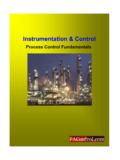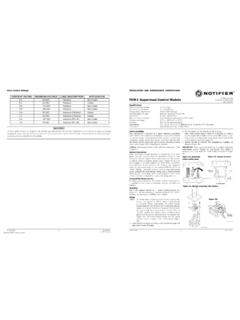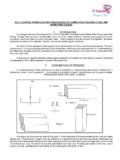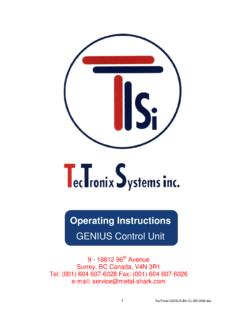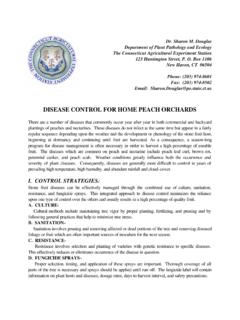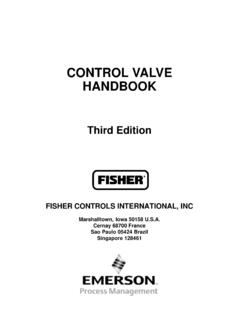Transcription of Iron Deficiency Anaemia - who.int
1 WHO/ IDA. This document deals primarily with Distribution: General Iron Deficiency Anaemia indicators for monitoring interventions to English only combat iron Deficiency , including iron Deficiency Anaemia , but it also reviews the current methods of assessing and preventing iron Deficiency in the light of recent significant scientific advances. Criteria for defining IDA, and the public severity of Anaemia based on prevalence estimates, are provided. Approaches to obtaining dietary information, and guidance in designing Iron Deficiency Anaemia national iron Deficiency prevention programmes, are presented. Assessment, Prevention, and control Strategies for preventing iron Deficiency through food-based approaches, A guide for programme managers dietary improvement or modification and fortification, and a schedule for A guide for programme managers using iron supplements to control iron Deficiency and to treat mild-to-moderate iron Deficiency Anaemia , are discussed.
2 For each strategy, desirable actions are outlined and criteria are suggested for assessment of the intervention. United Nations Children's Fund Attention is given to micronutrient complementarities in programme implementation, , the particularly close link between the improvement United Nations University of iron status and that of vitamin A. Finally, this document recommends World Health Organization action-oriented research on the control of iron Deficiency , providing guidance in undertaking feasibility studies on iron fortification in most countries. WHO/ IDA. This document deals primarily with Distribution: General Iron Deficiency Anaemia indicators for monitoring interventions to English only combat iron Deficiency , including iron Deficiency Anaemia , but it also reviews the current methods of assessing and preventing iron Deficiency in the light of recent significant scientific advances. Criteria for defining IDA, and the public severity of Anaemia based on prevalence estimates, are provided.
3 Approaches to obtaining dietary information, and guidance in designing Iron Deficiency Anaemia national iron Deficiency prevention programmes, are presented. Assessment, Prevention, and control Strategies for preventing iron Deficiency through food-based approaches, A guide for programme managers dietary improvement or modification and fortification, and a schedule for A guide for programme managers using iron supplements to control iron Deficiency and to treat mild-to-moderate iron Deficiency Anaemia , are discussed. For each strategy, desirable actions are outlined and criteria are suggested for assessment of the intervention. United Nations Children's Fund Attention is given to micronutrient complementarities in programme implementation, , the particularly close link between the improvement United Nations University of iron status and that of vitamin A. Finally, this document recommends World Health Organization action-oriented research on the control of iron Deficiency , providing guidance in undertaking feasibility studies on iron fortification in most countries.
4 IRON Deficiency Anaemia . Iron Deficiency Anaemia Assessment, Prevention and control A guide for programme managers IRON Deficiency Anaemia . WORLD HEALTH ORGANIZATION, 2001. This document is not a formal publication of the World Health Organization (WHO), and all rights are reserved by the Organization. The document may, however, be freely reviewed, abstracted, reproduced and translated, in part or in whole, but not for sale nor for use in conjunction with commercial purposes. The views expressed in documents by named authors are solely the responsibility of those authors. IRON Deficiency Anaemia . i Executive summary This document deals primarily with indicators for monitoring interventions to combat iron Deficiency , including iron Deficiency Anaemia . However, it also reviews the current methods of preventing iron Deficiency in the light of recent significant scientific advances. It summarizes regional prevalences of Anaemia , and briefly discusses the principal factors affecting its prevalence.
5 Indicators for assessing iron Deficiency are presented, together with their thresholds of abnormality in various age, gender, and physiological status;. the relationships between them; and their applicability in different settings ac- cording to resource availability. It also presents approaches for obtaining dietary information and guidance on designing national iron Deficiency prevention programmes. Iron requirements and recommended iron intakes from diets of different bioavailability are summarized. Criteria for defining iron Deficiency Anaemia are provided, and a slight modification from those previously recommended by WHO is proposed. Also proposed are criteria for defining the public health severity of Anaemia , on the basis of prevalence estimates. Acceptable methods for assessing Anaemia and iron status, both on the basis of clinical examinations and blood tests, are discussed. Threshold values for the interpretation of these indices are given.
6 Strategies for preventing iron Deficiency through food-based approaches, dietary improvement or modification and fortification, are discussed. For example, modifiers that affect the bioavailability of food-iron sources are reviewed, and suggestions for altering meal patterns to improve absorbability are offered. A schedule for using iron supplements to control iron Deficiency , and to treat mild-to-moderate IDA according to age, gender, and physiological status, is provided. For each strategy, desirable actions are outlined and criteria suggested for assessment of the intervention. In this connection, indicators for use in monitoring programme implementation are described. iii IRON Deficiency Anaemia . In most countries, some aspects of each of the main types of intervention will be needed to control the problem of iron Deficiency . Particular atten- tion is devoted to micronutrient complementarities in programme implementation.
7 For example, the particularly close link between improving iron status and improving vitamin A status is explored. Finally, recommendations are made for action-oriented research on the control of iron Deficiency , and for undertaking feasibility studies on iron fortification in countries. Increased advocacy, exchange of information, development of human resources, and action-oriented research are recommended for accelerating the achievement of the goals for reducing iron Deficiency . iv IRON Deficiency Anaemia . ii Contents Chapter Title Page i Executive summary iii ii Table of contents v iii List of tables viii iv List of figures ix v Abbreviations x vi Acknowledgements xi vii Preface xii 1 Introduction 1. 2 Concepts used in defining iron nutritional status 3. 3 Functional consequences of iron Deficiency 7. Cognitive development 7. Resistance to infection 8. Work capacity and productivity 9. Pregnancy 9.
8 Growth 9. Endocrine and neurotransmitters 10. Heavy-metal absorbtion 10. 4 Economic implications of iron Deficiency 11. 5 Prevalence and epidemiology of iron Deficiency 15. Prevalence 15. Epidemiology 17. v IRON Deficiency Anaemia . Contents (continued). Chapter Title Page 6 Assessment, surveillance, and indicators 23. Individual and population-based assessment 23. Purposes of biological assessments 24. Selection of subjects for assessment 25. General issues in defining iron status indicators 26. The spectrum of iron nutritional status 27. Application of iron-related indicators to specific settings 29. 7 Methods of assessing iron status 33. Assessment of Anaemia 33. Specific tests or procedures for assessing iron status 37. Defining iron Deficiency when multiple indices are available 41. Haemoglobin response to iron and other supplements or interventions 42. Assessing population iron status by using haemoglobin distributions 43.
9 8 Prevention strategies 47. Food-based approaches 47. Iron supplementation 56. 9 Action-oriented research needs 67. Dietary improvement 67. Iron fortification 68. Iron supplementation 69. 10 General recommendations 71. For governments 71. For supporting organizations and institutions 72. References 75. vi IRON Deficiency Anaemia . Contents (concluded). Annex Title Page 1 List of participants: IDA Consultation, Geneva 89. 2 The practical significance of iron overload for iron fortification and supplementation programmes 93. 3 Variations in haemoglobin and haematocrit levels 97. 4 Approaches for obtaining information on availability, dietary patterns, and consumption of iron-containing foods 103. 5 Strategies and guidelines for national IDA control programmes 107. vii IRON Deficiency Anaemia . iii Tables Number Title Page 1 Relative effectiveness and cost per Disability Adjusted Life Year of various prevention strategies 14.
10 2a Estimated percentages of Anaemia prevalence, based on blood haemoglobin concentration (1990-1995) 15. 2b Estimated prevalence of Anaemia by WHO Region, based on blood haemoglobin concentration (1990-1995) 16. 3 Proposed classification of public health significance of Anaemia in populations, on the basis of prevalence estimated from blood levels of haemoglobin or haematocrit 17. 4 Iron requirements and recommended iron intakes by age and gender group 18-19. 5 Assessing iron status on the basis of resource availability in a country 30. 6 Haemoglobin and haematocrit levels below which Anaemia is present in a population 33. 7 Relative extent of iron stores on the basis of serum ferritin concentration 38. 8 Changes in iron status by age group on the basis of erythrocyte protoporphyrin 39. 9 Proportion of anaemic pregnant women who responded to oral iron and vitamin A. supplements and became non-anaemic 42.










